Winter Persistent Extreme Cold Events in Xinjiang Region and Their Associations with the Quasi-Biweekly Oscillation of the Polar Front Jet
Abstract
1. Introduction
2. Data and Methods
2.1. Data
2.2. Methods
2.2.1. Recognition of the Winter Persistent Extreme Cold Event
2.2.2. Brief Introduction of Research Methods
3. Results
3.1. Basic Characteristics of WPECEs in China
3.1.1. Spatial Distribution of WPECEs
3.1.2. Inter-Annual and Inter-Decadal Variations of the WPECEs
3.1.3. Characteristics of Atmospheric Circulation Corresponding to WPECEs
3.2. Relationships between WPECEs and PFJ Intra-Seasonal Oscillation in Xinjiang, China
3.2.1. Characteristics of Low-Frequency Oscillation of PFJ in the Years of WPECEs
3.2.2. The QBWO of PFJ during WPECE
3.2.3. The Quasi-Biweekly Variations of Atmospheric Circulation
3.2.4. The Propagation of PFJ QBWO
4. Discussion
5. Conclusions
Author Contributions
Funding
Institutional Review Board Statement
Informed Consent Statement
Data Availability Statement
Acknowledgments
Conflicts of Interest
References
- Climate Change 2013: The Physical Science Basis. Available online: http://www.climatechange2013.org/images/report/WG1AR5_ALL_FINAL.pdf (accessed on 1 October 2013).
- Wen, M.; Yang, S.; Kumar, A.; Zhang, P.Q. An analysis of the large-scale climate anomalies associated with the snowstorms affecting china in January 2008. Mon. Weather Rev. 2009, 137, 1111–1131. [Google Scholar] [CrossRef]
- Sun, J.H.; Zhao, S.X. The Impacts of Multiscale Weather Systems on Freezing Rain and Snowstorms over Southern China. Weather Forecast. 2010, 25, 388–407. [Google Scholar] [CrossRef]
- Wang, Z.Y.; Ding, Y.H.; Zhou, B.T.; Chen, L.J. Comparison of two severe low-temperature snowstorm and ice freezing events in China: Role of Eurasian mid-high latitude circulation patterns. Int. J. Climatol. 2020, 40, 3436–3450. [Google Scholar] [CrossRef]
- Chen, J.H.; Jiang, H.; Wu, L.; Liao, X.; Lu, Y.N.; Tao, X.Q.; Deng, P.F.; Long, Y.; Huang, H.L. Association of ischemic and hemorrhagic strokes hospital admission with extreme temperature in Nanchang, China—A case-crossover study. J. Clin. Neurosci. 2017, 43, 89–93. [Google Scholar] [CrossRef]
- Luo, Y.X.; Li, H.B.; Huang, F.F.; Van Halm-Lutterodt, N.; Xu, Q.; Wang, A.X.; Guo, J.; Tao, L.X.; Li, X.; Liu, M.Y.; et al. The cold effect of ambient temperature on ischemic and hemorrhagic stroke hospital admissions: A large database study in Beijing, China between years 2013 and 2014—Utilizing a distributed lag non-linear analysis. Environ. Pollut. 2018, 232, 90–96. [Google Scholar] [CrossRef]
- Powell, J.P.; Reinhard, S. Measuring the effects of extreme weather events on yields. Weather Clim. Extrem. 2016, 12, 69–79. [Google Scholar] [CrossRef]
- Hanefeld, C.; Klaaßen-Mielke, R.; Miebach, J.; Muthers, S.; Haschemi, A.; Trampisch, H.; Kloppe, C.; Matzarakis, A.; Krogias, C.; Schroeder, C. Influence of extreme weather conditions on the deployment volume of emergency medical services. Med. Klin. Intensivmed. Notfmed. 2019, 116, 154–160. [Google Scholar] [CrossRef]
- Madden, R.A.; Julian, P.R. Detection of a 40–50 Day Oscillation in the Zonal Wind in the Tropical Pacific. J. Atmos. Sci. 1971, 28, 702–708. [Google Scholar] [CrossRef]
- Madden, R.A.; Julian, P.R. Description of Global-Scale Circulation Cells in the Tropics with a 40–50 Day Period. J. Atmos. Sci. 1972, 29, 1109–1123. [Google Scholar] [CrossRef]
- Anderson, J.R.; Rosen, R.D. The latitude-height structure of 40–50 day variations in atmospheric angular momentum. J. Atmos. Sci. 1983, 40, 1584–1591. [Google Scholar] [CrossRef]
- Li, C.Y.; Wu, P.L. An Observational Study of the 30–50 Day Atmospheric Oscillations Part I: Structure and Propagation. Adv. Atmos. Sci. 1990, 7, 294–304. [Google Scholar] [CrossRef]
- Krishnamurti, T.N.; Jayakumar, P.K.; Sheng, J.; Surgi, N.; Kumar, A. Divergent Circulations on the 30 to 50 Day Time Scale. J. Atmos. Sci. 1985, 42, 364–375. [Google Scholar] [CrossRef][Green Version]
- Krishnamurti, T.N.; Gadgil, S. On the structure of the 30 to 50 day mode over the globe during FGGE. Tellus 1985, 37A, 336–360. [Google Scholar] [CrossRef]
- Zhou, W.; Chan, J.C.L.; Chen, W.; Ling, J.; Pinto, J.G.; Shao, Y. Synoptic-scale controls of persistent low temperature and icy weather over southern China in January 2008. Mon. Weather Rev. 2009, 137, 3978–3991. [Google Scholar] [CrossRef]
- Ding, Y.H. Build-Up, Air Mass Transformation and Propagation of Siberian High and Its Relations to Cold Surge in East Asia. Meteor. Atmos. Phys. 1990, 44, 281–292. [Google Scholar] [CrossRef]
- Gong, D.Y.; Ho, C.H. Intra-seasonal variability of wintertime temperature over East Asia. Int. J. Climatol. 2004, 24, 131–144. [Google Scholar] [CrossRef]
- Jiang, X.N.; Adames, N.F.; Kim, D.; Maloney, E.D.; Lin, H.; Kim, H.; Zhang, C.D.; Demott, C.A.; Klingaman, N.P. Fifty Years of Research on the Madden-Julian Oscillation: Recent Progress, Challenges, and Perspectives. J. Geophys. Res. Atmos. 2020, 125. [Google Scholar] [CrossRef]
- Liu, Y.Y.; Hu, Z.Z.; Wu, R.G.; Jha, B.; Li, Q.P.; Chen, L.J.; Yan, J.H. Subseasonal prediction and predictability of summer rainfall over eastern China in BCC_AGCM2.2. Clim. Dyn. 2021, 1–13. [Google Scholar] [CrossRef]
- Xiang, B.Q.; Sun, Y.Q.; Chen, J.H.; Johnson, N.C.; Jiang, X.N. Subseasonal Prediction of Land Cold Extremes in Boreal Wintertime. J. Geophys. Res. Atmos. 2020, 125. [Google Scholar] [CrossRef]
- Cheung, H.H.N.; Zhou, W. Implications of Ural Blocking for East Asian Winter Climate in CMIP5 GCMs. Part I: Biases in the Historical Scenario. J. Clim. 2015, 28, 2203–2216. [Google Scholar] [CrossRef]
- Bueh, C.; Shi, N.; Xie, Z.W. Large-scale circulation anomalies associated with persistent low temperature over southern China in January 2008. Atmos. Sci. Lett. 2011, 12, 273–280. [Google Scholar] [CrossRef]
- Shi, N.; Bueh, C. A specific stratospheric precursory signal for the extensive and persistent extreme cold events in China. Chin. J. Atmos. Sci. 2015, 39, 210–220. (In Chinese) [Google Scholar] [CrossRef]
- Ji, L.R.; Sun, S.Q.; Arpe, K.; Bengtsson, L. Model study on the interannual variability of Asian winter monsoon and its influence. Adv. Atmos. Sci. 1997, 14, 1–22. [Google Scholar] [CrossRef]
- Wang, L.; Chen, W. The East Asian winter monsoon: Re-amplification in the mid-2000s. Chin. Sci. Bull. 2014, 59, 430–436. [Google Scholar] [CrossRef]
- Huang, R.H.; Chen, J.L.; Wang, L.; Lin, Z.D. Characteristics, processes, and causes of the spatio-temporal variabilities of the East Asian monsoon system. Adv. Atmos. Sci. 2013, 29, 910–942. [Google Scholar] [CrossRef]
- Kuang, X.Y.; Zhang, Y.C.; Huang, D.Q.; Huang, Y. Regionality of record-breaking low temperature events in China and its associated circulation. Clim. Dyn. 2016, 46, 1719–1731. [Google Scholar] [CrossRef]
- Luo, X.; Zhang, Y.C. The Linkage between Upper-Level Jet Streams over East Asia and East Asian Winter Monsoon Variability. J. Clim. 2015, 28, 9013–9028. [Google Scholar] [CrossRef]
- Zhang, Y.C.; Chen, J. Characterizing the Winter Concurrent Variation Patterns of the Subtropical and Polar-Front Jets over East Asia. J. Meteorol. Res. 2017, 31, 160–170. [Google Scholar] [CrossRef]
- Xue, D.K.; Zhang, Y.C. Concurrent variations in the location and intensity of the Asian winter jet streams and the possible mechanism. Clim. Dyn. 2017, 49, 37–52. [Google Scholar] [CrossRef]
- Ren, Z.H.; Zou, F.L.; Yu, Y.; Wang, G.A. Daily Value Dataset of China’s Surface Climate Data. 7 May 2020. Available online: http://data.cma.cn (accessed on 7 May 2020).
- Kalnay, E.; Kanamitsu, M.; Kistler, R.; Collins, W.; Deaven, D.; Gandin, L.; Iredell, M.; Saha, S.; White, G.; Woollen, J.; et al. The NCEP/NCAR 40-Year Reanalysis Project. Bull. Am. Meteorol. Soc. 1996, 77, 437–471. [Google Scholar] [CrossRef]
- Yan, Z.; Jones, P.D.; Davies, T.D.; Moberg, A.; Bergstrm, H.; Camuffo, D.; Cocheo, C.; Maugeri, M.; Demare, G.R.; Verhoeve, T. Trends of Extreme Temperatures in Europe and China Based on Daily Observations. Clim. Chang. 2002, 53, 355–392. [Google Scholar] [CrossRef]
- Zhang, Z.J.; Qian, W.H. Identifying Regional Prolonged Low Temperature Events in China. Adv. Atmos. Sci. 2011, 28, 338–351. [Google Scholar] [CrossRef]
- Shi, N.; Wang, X.Q.; Tian, P.Y. Interdecadal variations in persistent anomalous cold events over Asian mid-latitudes. Clim. Dyn. 2018, 52, 3729–3739. [Google Scholar] [CrossRef]
- Jiang, X.N.; Waliser, D.E. Northward propagation of the subseasonal variability over the eastern Pacific warm pool. Geophys. Res. Lett. 2008, 35, 697–711. [Google Scholar] [CrossRef]
- Li, J.Y.; Wen, M.; Wang, Z.Y.; Hu, Y. Relations between the quasi-biweekly oscillation over the East Asian monsoon region and the East Asian tropical monsoon depressions. Int. J. Climatol. 2020, 41. [Google Scholar] [CrossRef]
- Wen, M.; Yang, S.; Higgins, W.; Zhang, R.H. Characteristics of the Dominant Modes of Atmospheric Quasi-Biweekly Oscillation over Tropical-Subtropical Americas. J. Clim. 2011, 24, 3956–3970. [Google Scholar] [CrossRef]
- Murakami, M. Large-Scale Aspects of Deep Convective Activity over the GATE Area. Mon. Weather Rev. 1979, 107, 994–1013. [Google Scholar] [CrossRef]
- Shanks, J.L. Recursion filters for digital processing. Geophysics 1967, 32, 33–51. [Google Scholar] [CrossRef]
- Bueh, C.; Fu, X.Y.; Xie, Z.W. Large-Scale Circulation Features Typical of Wintertime Extensive and Persistent Low Temperature Events in China. Atmos. Oceanic Sci. Lett. 2011, 4, 235–241. [Google Scholar] [CrossRef]
- Wang, L.; Chen, W.; Zhou, W.; Huang, R.H. Interannual Variations of East Asian Trough Axis at 500 hPa and its Association with the East Asian Winter Monsoon Pathway. J. Clim. 2009, 22, 600–614. [Google Scholar] [CrossRef]
- Fu, X.Y.; Bueh, C. Wintertime extensive and persistent low-temperature events of China and anomalous precipitation over southern China. Chin. J. Atmos. Sci. 2013, 37, 1247–1260. (In Chinese) [Google Scholar] [CrossRef]
- Yu, W.Q.; Gao, Q.J. Analysis and Diagnosis of Low-Frequency Characteristics in a Low Temperature Event in Southern China in the Winter of 1996. Chin. J. Atmos. Sci. 2020, 44, 257–268. (In Chinese) [Google Scholar] [CrossRef]
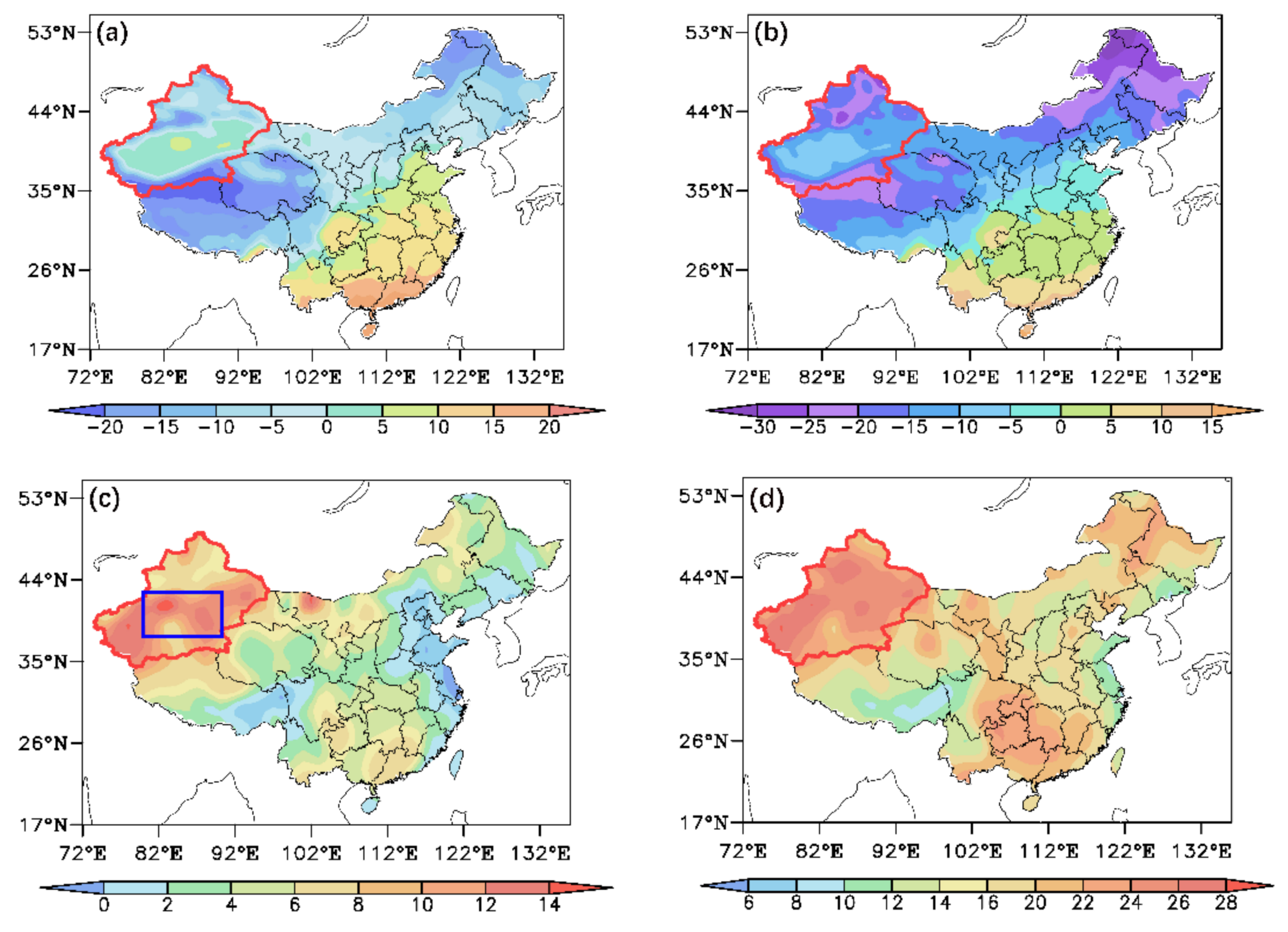
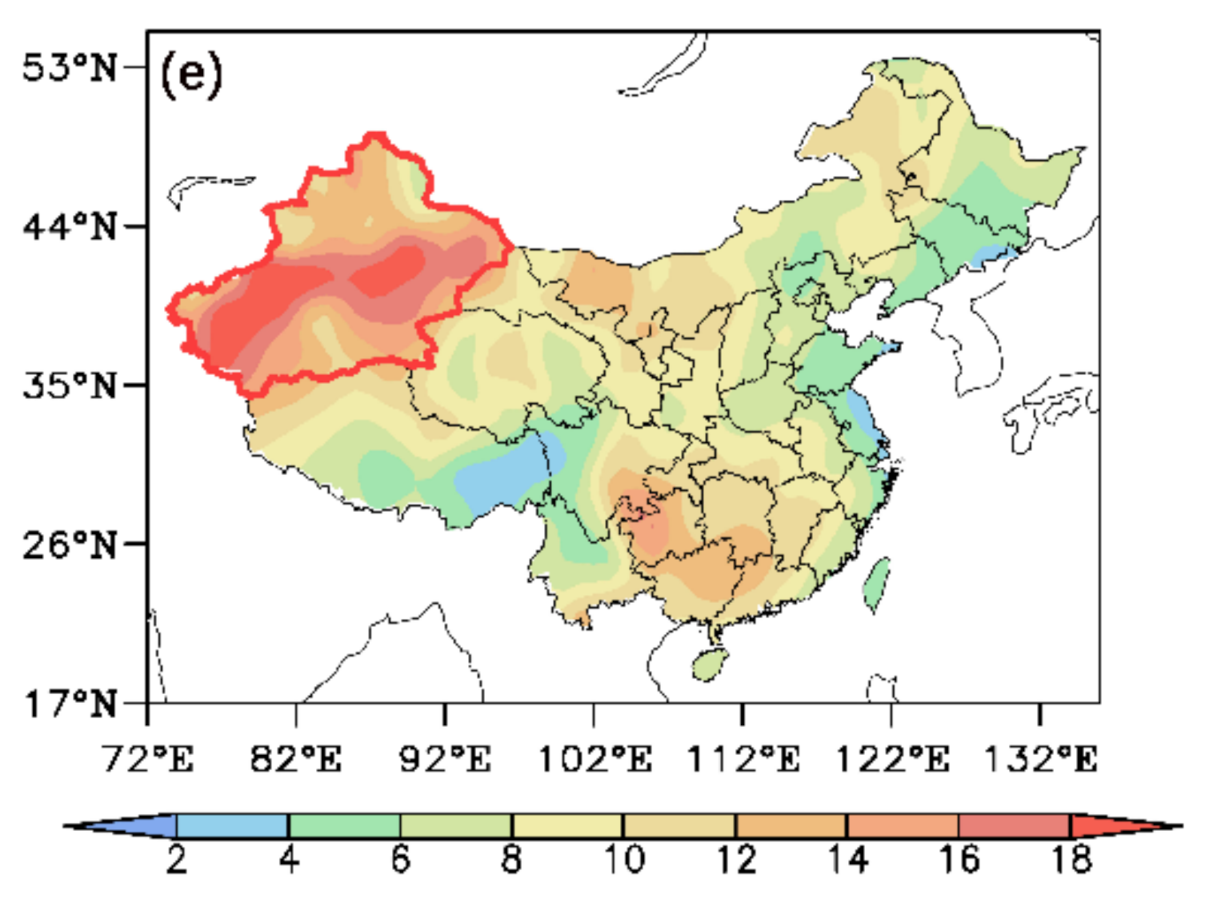

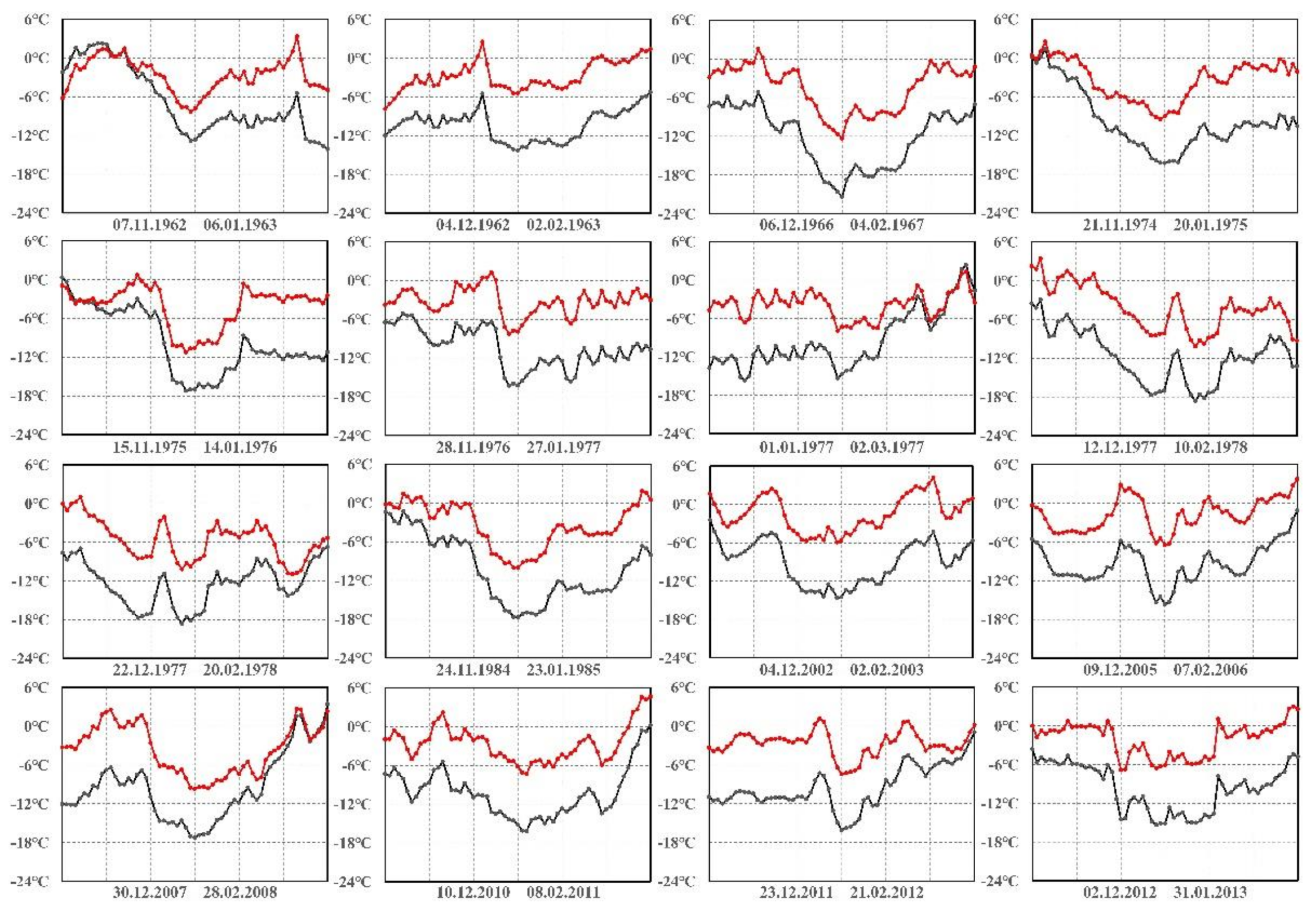

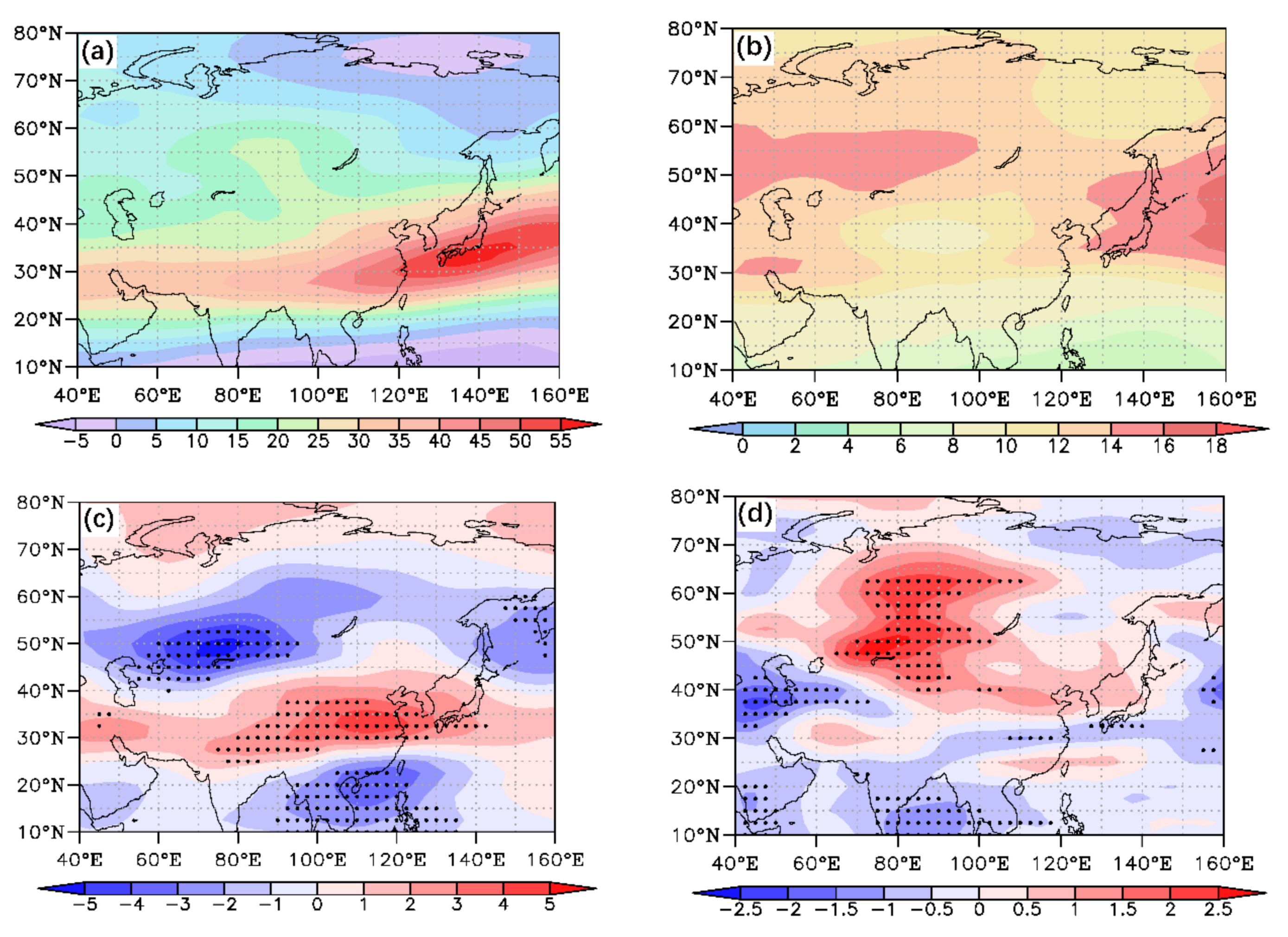
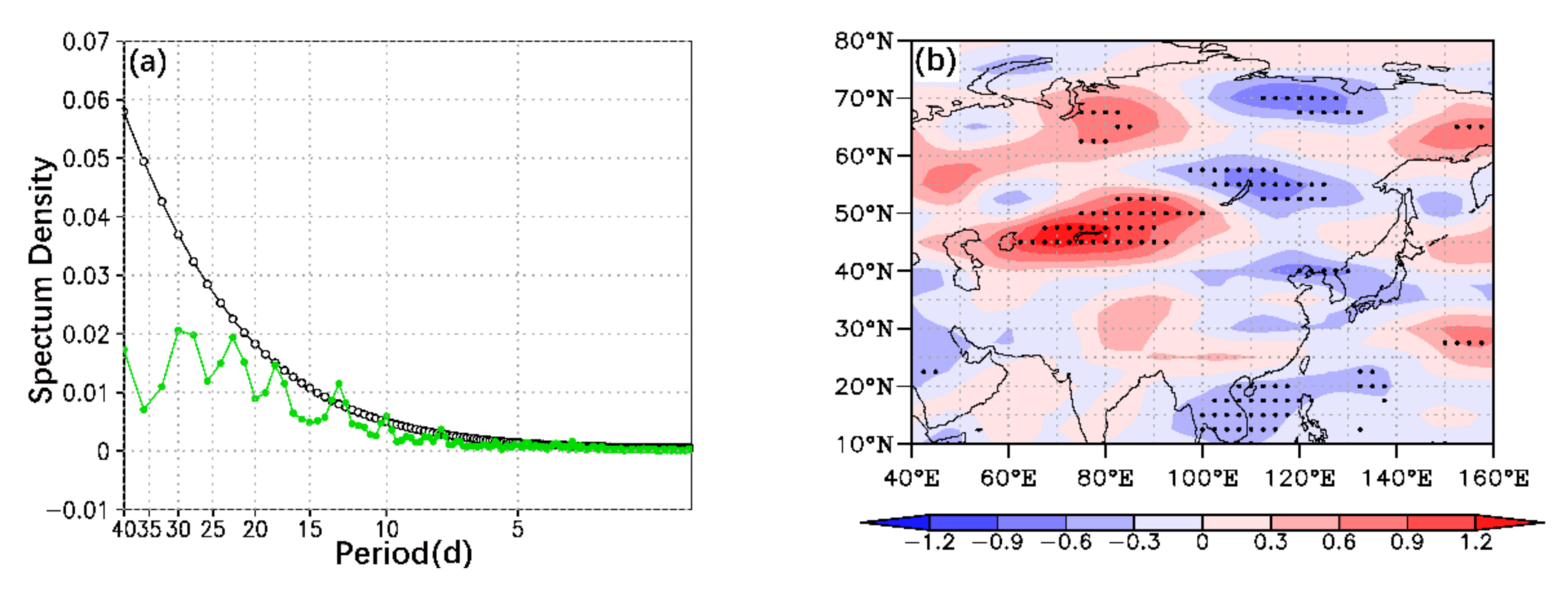
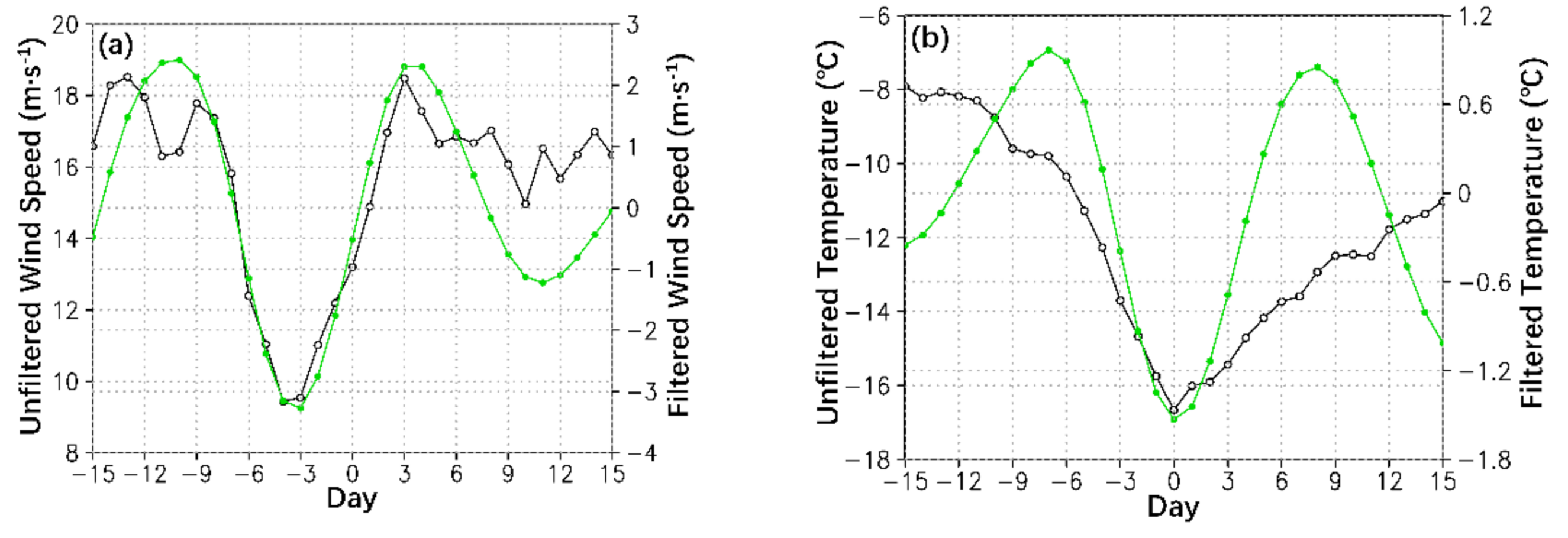
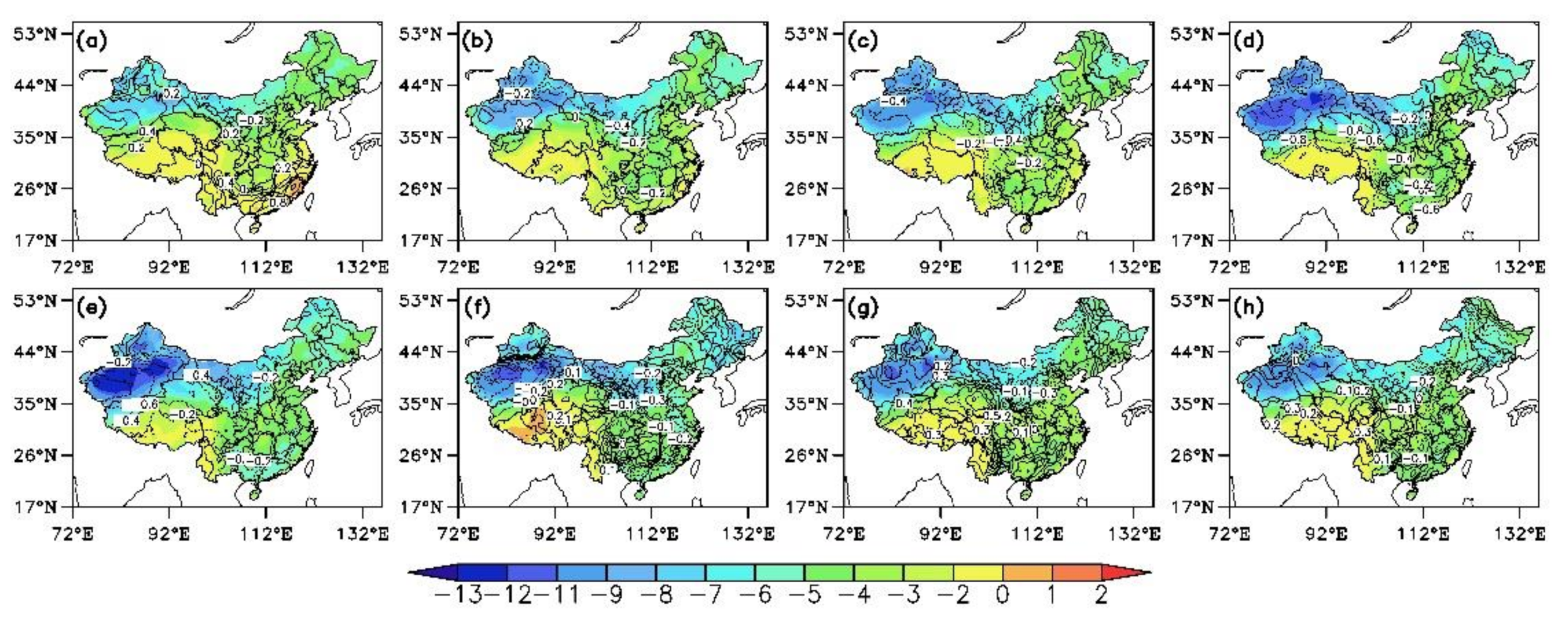

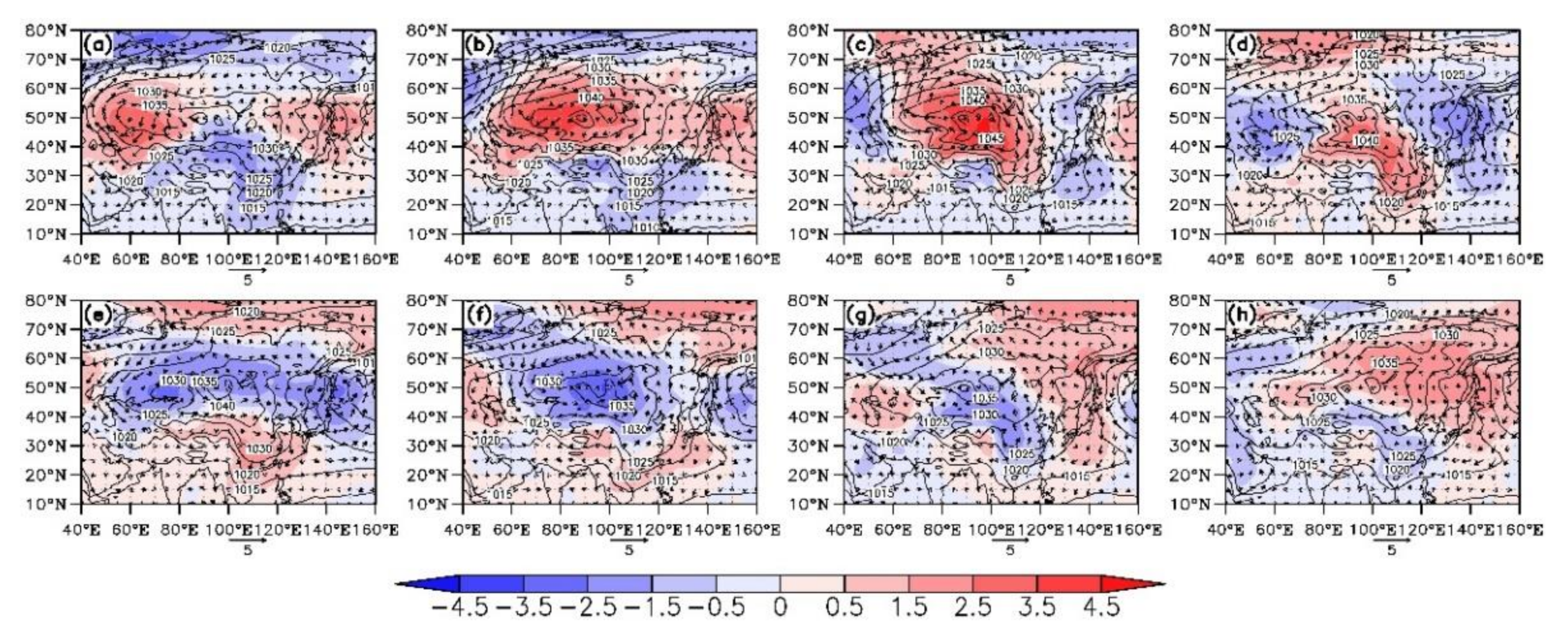
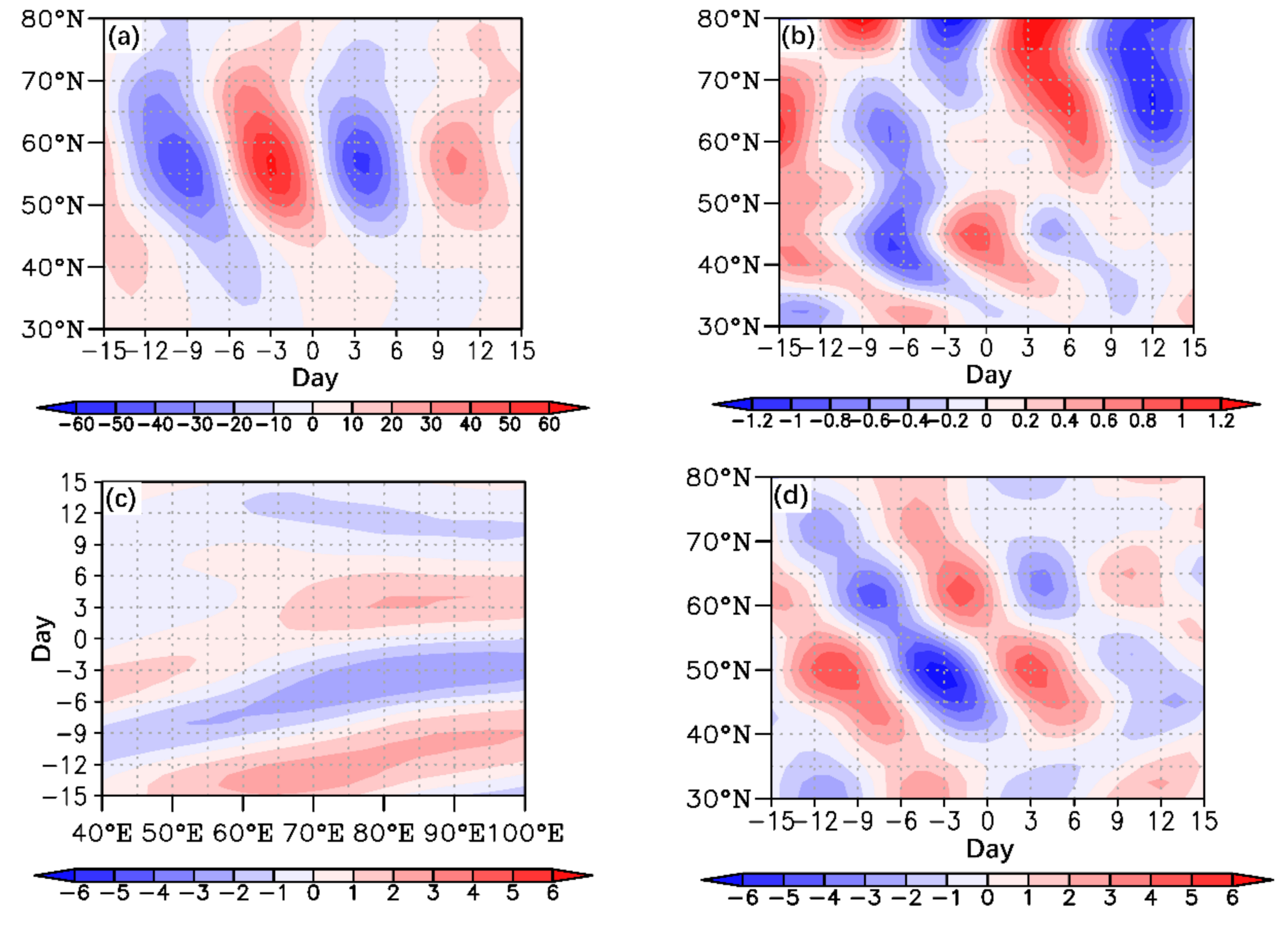
Publisher’s Note: MDPI stays neutral with regard to jurisdictional claims in published maps and institutional affiliations. |
© 2021 by the authors. Licensee MDPI, Basel, Switzerland. This article is an open access article distributed under the terms and conditions of the Creative Commons Attribution (CC BY) license (https://creativecommons.org/licenses/by/4.0/).
Share and Cite
Jiang, J.; Yao, S. Winter Persistent Extreme Cold Events in Xinjiang Region and Their Associations with the Quasi-Biweekly Oscillation of the Polar Front Jet. Atmosphere 2021, 12, 597. https://doi.org/10.3390/atmos12050597
Jiang J, Yao S. Winter Persistent Extreme Cold Events in Xinjiang Region and Their Associations with the Quasi-Biweekly Oscillation of the Polar Front Jet. Atmosphere. 2021; 12(5):597. https://doi.org/10.3390/atmos12050597
Chicago/Turabian StyleJiang, Jie, and Suxiang Yao. 2021. "Winter Persistent Extreme Cold Events in Xinjiang Region and Their Associations with the Quasi-Biweekly Oscillation of the Polar Front Jet" Atmosphere 12, no. 5: 597. https://doi.org/10.3390/atmos12050597
APA StyleJiang, J., & Yao, S. (2021). Winter Persistent Extreme Cold Events in Xinjiang Region and Their Associations with the Quasi-Biweekly Oscillation of the Polar Front Jet. Atmosphere, 12(5), 597. https://doi.org/10.3390/atmos12050597




